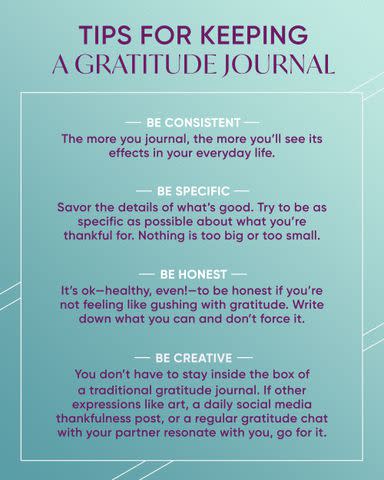Your Complete Guide to Gratitude Journaling
Grab a pen and paper and let your thankfulness flow.

Getty Images / SHAPE
Gratitude is an awesome feeling. Identifying all that’s good in our lives and giving thanks for it has a way of grounding us, reminding us that, no matter what, we’re lucky to be on this planet every day. When we count our blessings, it often puts frustrations (and even the bigger stressors in life) into perspective. From a vantage point of thankfulness, we’re better able to see the upside, even in the tough stuff.
Wish you could hang onto the good vibes of gratitude even longer? One way to do so is to put your thanks on paper. Gratitude journaling isn’t just for the days around Thanksgiving (though this time of year can be a great place to start). It’s an excellent habit that can carry you through the entire year with a sunnier outlook. Writing down your thankful thoughts has tons of documented benefits for mental, emotional, and spiritual health—not the least of which is feeling happier!
So grab that cute notebook that’s been sitting on your shelf and let’s get thankful.
What is Gratitude Journaling?
Much like regular journaling, gratitude journaling can look different for everyone. In studies on thankfulness practices, researchers have used methods like written prompts about thankfulness, penning gratitude letters (sent or unsent) to others, or writing down three things each day to be grateful for. According to a 2020 research review in The Journal of Positive Psychology, “gratitude journaling consists of writing on a regular basis about things, people, and events one feels explicitly grateful for.”
It's a definition that casts a wide net—so how you interpret gratitude journaling is up to you. You might simply start with recording one thing each day you’re thankful for (in seasons of difficulty or depression, this might feel like all you can muster). Or list as many things as you can think of! Again, writing letters of thanks to people who have impacted you in positive ways or finding thankfulness writing prompts online can also get the gratitude juices flowing. If you’re artsy, you could even include drawings of things you’re grateful for.

Getty Images
Related: The 11 Best Guided Journals of 2023, Picked By Mental Health Pros
The Benefits of Gratitude Journaling
There’s a big ol’ body of research showing that gratitude practices can improve our lives. Possibly the best result: people who give thanks more are typically happier. According to Harvard Health, when people wrote and delivered a letter of thanks to someone who had been kind to them, they experienced a dramatic increase in happiness scores that lasted a whole month.
In a 2020 study, people who participated in a 6-week gratitude intervention, which consisted mostly of writing exercises, had greater mental well-being up to 6 months later. Not surprisingly, the National Institutes of Health reports that there may be a connection between a daily gratitude practice and lower levels of stress.
Giving thanks could even give you a better night’s sleep. An older study found that gratitude was a predictor of sleep quality and duration, likely because it helped people have more positive thoughts at bedtime. And as we all know, better sleep leads to better mood.
Meanwhile, showing gratitude to others is also a way to strengthen relationships. In friendships, family connections, or romantic relationships, expressing thanks acknowledges another person’s positive impact on us and validates them for it. Some researchers have called this the “find, remind, bind” theory—meaning that gratitude finds the good in others, reminds us of it, and binds us together. When we feel a greater social connection, a happier mental state often follows.
How Can Self-Reflection Promote Happiness?
As you paint the town with gratitude, you might also experience the quieter, less expected benefit of greater self-understanding. Writing down what you’re grateful for points a mirror at your inner reality. The more you know yourself, the more you’ll know what makes you feel good—and, ultimately, what happiness looks like to you. When you can clearly see your own version of happiness, you can seek more of it in your everyday life.
How to Start a Gratitude Journal
Ready, set, gratitude! Starting a thankfulness journal is a totally individual endeavor, so choose a method that works for your personality and your schedule. Take a little time to contemplate how often you’d like to write. Daily? Weekly? Monthly? Then consider which method(s) appeal to you. Maybe you’d enjoy writing letters of thanks to others, responding to writing prompts in a purchased gratitude journal, free writing on your own, or simply creating a bullet point list of, say, five things you’re thankful for each day.
Finding a journal that appeals to you visually can make gratitude writing a regular habit. Whether that’s an attractive leather-bound book or Lisa Frank-style ‘90s spiral throwback, you do you. And remember that a “real” journal isn’t the only option. You can stick to the process with a digital document on your phone or computer, or keep a whiteboard somewhere clearly visible in your home. Start each day writing down your thanks, then keep it in sight all day long.
Most importantly: just get writing. Try habit-stacking gratitude journaling onto something else you already do regularly. (Let your bedtime tooth brushing or morning coffee be a reminder to get writing, for example.) Or if you already journal, there’s nothing wrong with simply adding a thankfulness section to your regular writing. As long as you’re identifying and expressing thanks, your brain and body will benefit.

SHAPE
Related: The Best Journal Apps for 'Writing Down' All Your Thoughts
For more Shape news, make sure to sign up for our newsletter!
Read the original article on Shape.

